Study on the Correlation between Magnetic Field Structure and Cold Electron Transport in Negative Hydrogen Ion Sources
Abstract
:1. Introduction
2. Simulation Model and Methods
3. Numerical Results and Analysis
3.1. Magnetic Filter Field Simulation Result
3.2. Calculation of Electron Energy Probability Function
3.3. Influence of Different Collision Reactions on Electron Energy Distribution
4. Conclusions
Author Contributions
Funding
Institutional Review Board Statement
Informed Consent Statement
Data Availability Statement
Conflicts of Interest
References
- Fantz, U.; Franzen, P.; Kraus, W.; Berger, M.; Christ-Koch, S.; Fröschle, M.; Gutser, R.; Heinemann, B.; Martens, C.; McNeely, P.; et al. Negative ion RF sources for ITER NBI: Status of the development and recent achievements. Plasma Phys. Control. Fusion 2007, 49, B563–B580. [Google Scholar] [CrossRef]
- Speth, E.; Falter, H.D.; Franzen, P.; Fantz, U.; Bandyopadhyay, M.; Christ, S.; Encheva, A.; Fröschle, M.; Holtum, D.; Heinemann, B.; et al. Overview of the RF source development programme at IPP Garching. Nucl. Fusion 2006, 46, S220–S238. [Google Scholar] [CrossRef] [Green Version]
- Wilson, J.; Becnel, J.; Demange, D.; Rogers, B. The ITER Tokamak Exhaust Processing System Design and Substantiation. Fusion Sci. Technol. 2019, 75, 794–801. [Google Scholar] [CrossRef]
- Hemsworth, R.; Decamps, H.; Graceffa, J.; Schunke, B.; Tanaka, M.; Dremel, M.; Tanga, A.; De Esch, H.P.L.; Geli, F.; Milnes, J.; et al. Status of the ITER heating neutral beam system. Nucl. Fusion 2009, 49, 045006. [Google Scholar] [CrossRef] [Green Version]
- Hurlbatt, A.; den Harder, N.; Fantz, U. Improved understanding of beamlet deflection in ITER-relevant negative ion beams through forward modelling of Beam Emission Spectroscopy. Fusion Eng. Des. 2020, 153, 111486. [Google Scholar] [CrossRef]
- Luchetta, A.; Manduchi, G.; Taliercia, C.; Breda, M.; Capobianco, R.; Molon, F.; Moressa, M.; Simionata, P.; Zampiva, E. Integrating supervision, control and data acquisition—The ITER Neutral Beam Test Facility experience. Fusion Eng. Des. 2016, 112, 928–931. [Google Scholar] [CrossRef]
- Toigo, V.; Bonicelli, T.; Hanada, M.; Chakraborty, A.; Agarici, G.; Antoni, V.; Baruah, U.; Bigi, M.; Chitarin, G.; Dal Bello, S.; et al. Progress in the realization of the PRIMA neutral beam test facility. Nucl. Fusion 2015, 55, 83025. [Google Scholar] [CrossRef]
- Toigo, V.; Dal Bello, S.; Bigi, M.; Boldrin, M.; Chitarin, G.; Luchetta, A.; Marcuzzi, D.; Pomaro, N.; Serianni, G.; Zaccaria, P.; et al. Progress in the ITER neutral beam test facility. Nucl. Fusion 2019, 59, 86058. [Google Scholar] [CrossRef]
- Poggi, C.; Berton, G.; Brombin, M.; Degli Agostini, F.; Fasolo, D.; Franchin, L.; Laterza, B.; Pasqualotto, R.; Ravarotto, D.; Sartori, E.; et al. First tests and commissioning of the emittance scanner for SPIDER. Fusion Eng. Des. 2021, 168, 112659. [Google Scholar] [CrossRef]
- Kraus, W.; Fantz, U.; Franzen, P.; Fröschle, M.; Heinemann, B.; Riedl, R.; Wünderlich, D. The development of the radio frequency driven negative ion source for neutral beam injectors (invited)a. Rev. Sci. Instrum. 2012, 83, 02B104. [Google Scholar] [CrossRef]
- Gutser, R.; Fantz, U.; Wünderlich, D. Simulation of cesium injection and distribution in rf-driven ion sources for negative hydrogen ion generation. Rev. Sci. Instrum. 2010, 81, 02A706. [Google Scholar] [CrossRef]
- Heinemann, B.; Fantz, U.; Kraus, W.; Schiesko, L.; Wimmer, C.; Wünderlich, D.; Bonomo, F.; Fröschle, M.; Nocentini, R.; Riedl, R. Towards large and powerful radio frequency driven negative ion sources for fusion. New J. Phys. 2017, 19, 15001. [Google Scholar] [CrossRef]
- Taniguchi, M.; Hanada, M.; Iga, T.; Inoue, T.; Kashiwagi, M.; Morisita, T.; Okumura, Y.; Shimizu, T.; Takayanagi, T.; Watanabe, K.; et al. Development of high performance negative ion sources and accelerators for MeV class neutral beam injectors. Nucl. Fusion 2003, 43, 665–669. [Google Scholar] [CrossRef]
- Heinemann, B.; Falter, H.D.; Fantz, U.; Franzen, P.; Froeschle, M.; Kraus, W.; Martens, C.; Nocentini, R.; Riedl, R.; Speth, E.; et al. The negative ion source test facility ELISE. Fusion Eng. Des. 2011, 86, 768–771. [Google Scholar] [CrossRef]
- Bansal, G.; Gahlaut, A.; Soni, J.; Pandya, K.; Parmar, K.G.; Pandey, R.; Vuppugalla, M.; Prajapati, B.; Patel, A.; Mistery, H.; et al. Negative ion beam extraction in ROBIN. Fusion Eng. Des. 2013, 88, 778–782. [Google Scholar] [CrossRef]
- Song, F.; Zuo, C.; Li, D.; Chen, D.Z. Beam loss analysis for the negative ion source at HUST. Fusion Eng. Des. 2021, 173, 112853. [Google Scholar] [CrossRef]
- Wei, J.L.; Hu, C.D.; Xie, Y.H.; Jiang, C.C.; Liang, L.Z.; Wang, Y.; Gu, Y.M.; Yan, J.Y.; Xu, Y.J.; Xie, Y.L. Development of a Utility Negative Ion Test Equipment with RF Source at ASIPP. IEEE Trans. Plasma Sci. 2018, 46, 1149–1155. [Google Scholar] [CrossRef]
- Fubiani, G.; Boeuf, J.P. Role of positive ions on the surface production of negative ions in a fusion plasma reactor type negative ion source—Insights from a three-dimensional particle-in-cell Monte Carlo collisions model. Phys. Plasmas 2013, 20, 113511. [Google Scholar] [CrossRef]
- Demerdjiev, A.; Goutev, N.; Tonev, D. Simulations of negative hydrogen ion sources. J. Phys. Conf. Ser. 2018, 1023, 12033. [Google Scholar] [CrossRef] [Green Version]
- Shah, M.; Chaudhury, B.; Bandyopadhyay, M.; Chakraborty, A. Computational characterization of plasma transport across magnetic filter in ROBIN using PIC-MCC simulation. Fusion Eng. Des. 2020, 151, 111402. [Google Scholar] [CrossRef]
- McNeely, P.; Dudin, S.V.; Christ-Koch, S.; Fantz, U. A Langmuir probe system for high power RF-driven negative ion sources on high potential. Plasma Sources Sci. Technol. 2009, 18, 014011. [Google Scholar] [CrossRef]
- Franzen, P.; Schiesko, L.; Fröschle, M.; Wünderlich, D.; Fantz, U. Magnetic filter field dependence of the performance of the RF driven IPP prototype source for negative hydrogen ions. Plasma Phys. Control. Fusion 2011, 53, 115006. [Google Scholar] [CrossRef] [Green Version]
- Schiesko, L.; McNeely, P.; Franzen, P.; Fantz, U. Magnetic field dependence of the plasma properties in a negative hydrogen ion source for fusion. Plasma Phys. Control Fusion 2012, 54, 105002. [Google Scholar] [CrossRef]
- Cho, W.H.; Dang, J.J.; Kim, J.Y.; Chung, K.J.; Hwang, Y.S. Optimization of plasma parameters with magnetic filter field and pressure to maximize H-ion density in a negative hydrogen ion source. Rev. Sci. Instrum. 2016, 87, 02B136. [Google Scholar] [CrossRef]
- Birdsall, C.K. Particle-in-cell charged-particle simulations, plus Monte Carlo collisions with neutral atoms, PIC-MCC. IEEE Trans. Plasma Sci. 1991, 19, 65–85. [Google Scholar] [CrossRef]
- Xie, M.J.; Liu, D.G.; Liu, L.Q.; Wang, H.H. Influence of magnetic shielding on electron dynamics characteristics of Penning ion source. AIP Adv. 2021, 11, 075123. [Google Scholar] [CrossRef]
- Zhou, J.; Liu, D.G.; Liao, C.; Li, Z.H. CHIPIC: An Efficient Code for Electromagnetic PIC Modeling and Simulation. IEEE Trans. Plasma Sci. 2009, 37, 2002–2011. [Google Scholar] [CrossRef]
- Zhou, J.; Liu, D.G.; Liao, C. Modeling and simulations of high-power microwave devices using the CHIPIC code. J. Plasma Phys. 2013, 79, 69–86. [Google Scholar] [CrossRef]
- Hagelaar, G.J.M.; Fubiani, G.; Boeuf, J.P. Model of an inductively coupled negative ion source: I. General model description. Plasma Source Sci. Technol. 2011, 20, 015001. [Google Scholar] [CrossRef]
- Boeuf, J.P.; Hagelaar, G.J.M.; Sarrailh, P.; Fubiani, G.; Kohen, N. Model of an inductively coupled negative ion source: II. Application to an ITER type source. Plasma Source Sci. Technol. 2011, 20, 015002. [Google Scholar] [CrossRef]
- Fantz, U.; Falter, H.; Franzen, P.; Wünderlich, D.; Berger, M.; Lorenz, A.; Kraus, W.; McNeely, P.; Riedl, R.; Spetha, E. Spectroscopy—A powerful diagnostic tool in source development. Nucl. Fusion 2006, 46, S297–S306. [Google Scholar] [CrossRef] [Green Version]
- Kolev, S.; Hagelaar, G.J.M.; Boeuf, J.P. Particle-in-cell with Monte Carlo collision modeling of the electron and negative hydrogen ion transport across a localized transverse magnetic field. Phys. Plasma 2009, 16, 042318. [Google Scholar] [CrossRef] [Green Version]
- Gutser, R.; Wünderlich, D.; Fantz, U. Negative hydrogen ion transport in RF-driven ion sources for ITER NBI. Plasma Phys. Control. Fusion 2009, 51, 045005. [Google Scholar] [CrossRef] [Green Version]
- Fantz, U.; Wünderlich, D. A novel diagnostic technique for H-(D-) densities in negative hydrogen ion source. New J. Phys. 2006, 8, 301. [Google Scholar] [CrossRef]
- Yoon, J.S.; Song, M.Y.; Han, J.M.; Hwang, S.H.; Chang, W.S.; Lee, B.J.; Itikawa, Y. Cross Sections for Electron Collisions with Hydrogen Molecules. J. Phys. Chem. Ref. Data 2008, 37, 913–931. [Google Scholar] [CrossRef]
- Terasaki, R.; Fujino, I.; Hatayama, A.; Mizuno, T.; Inoue, T. 3D modeling of the electron energy distribution function in negative hydrogen ion sources. Rev. Sci. Instrum. 2010, 81, 02A703. [Google Scholar] [CrossRef]
- Yang, Y.P.; Lou, L.P.; Yang, C.; Liu, D.G. A New Difference Scheme about Three-dimensional Permanent Magnet Calculation. Mod. Electron. Tech. 2010, 33, 130–132. (In Chinese) [Google Scholar] [CrossRef]
- Wang, H.H.; Meng, L.; Liu, D.G.; Liu, L.Q.; Yang, C. The effect of the H2 density on the electron energy distribution in H-ion sources. Rev. Sci. Instrum. 2013, 84, 093304. [Google Scholar] [CrossRef]
- Fantz, U. Basics of plasma spectroscopy. Plasma Source Sci. Technol. 2006, 15, S137–S147. [Google Scholar] [CrossRef] [Green Version]
- Schlickeiser, R.; Jenko, F. Cosmic ray transport in non-uniform magnetic fields: Consequences of gradient and curvature drifts. J. Plasma Phys. 2010, 76, 317–327. [Google Scholar] [CrossRef]
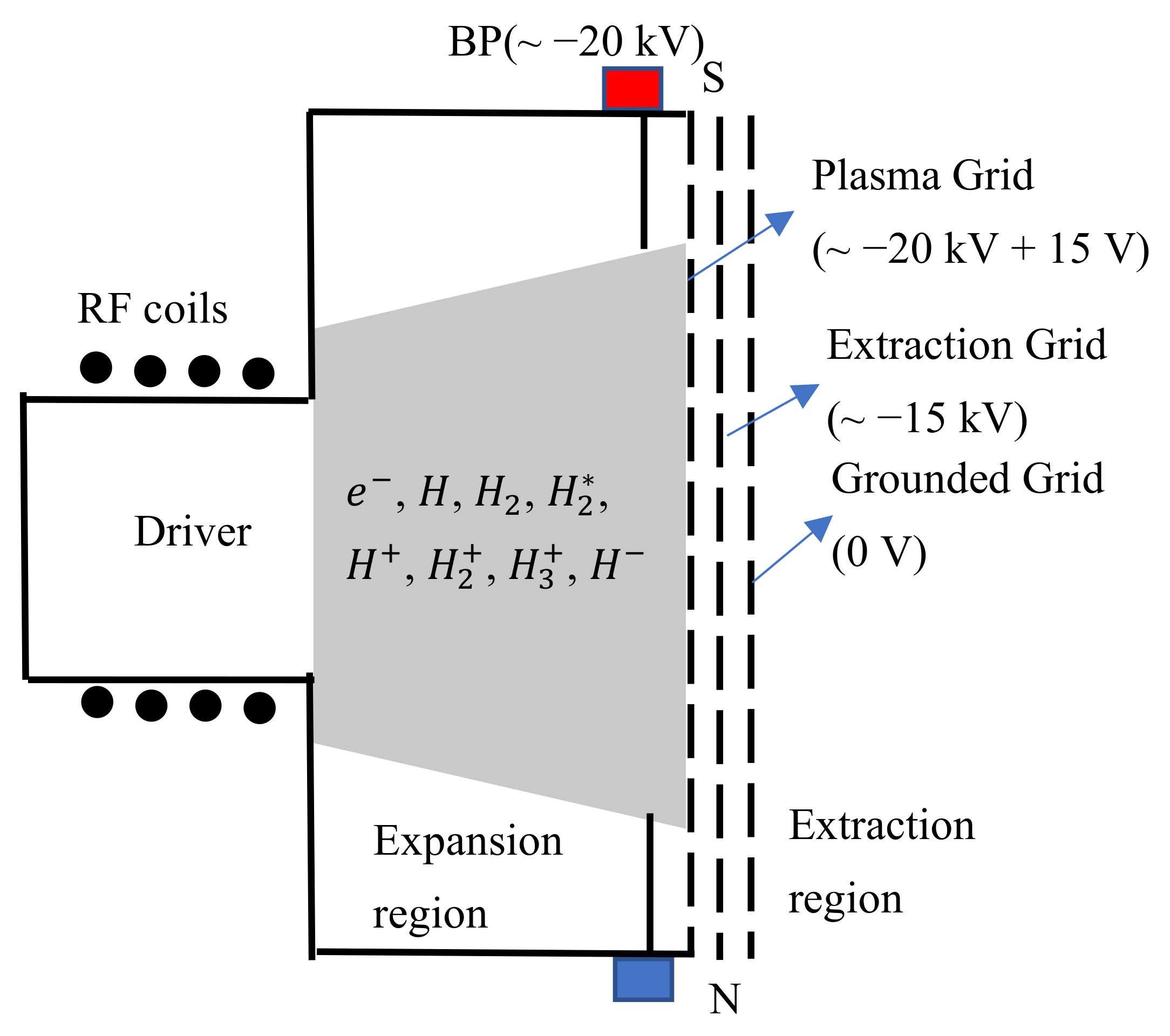
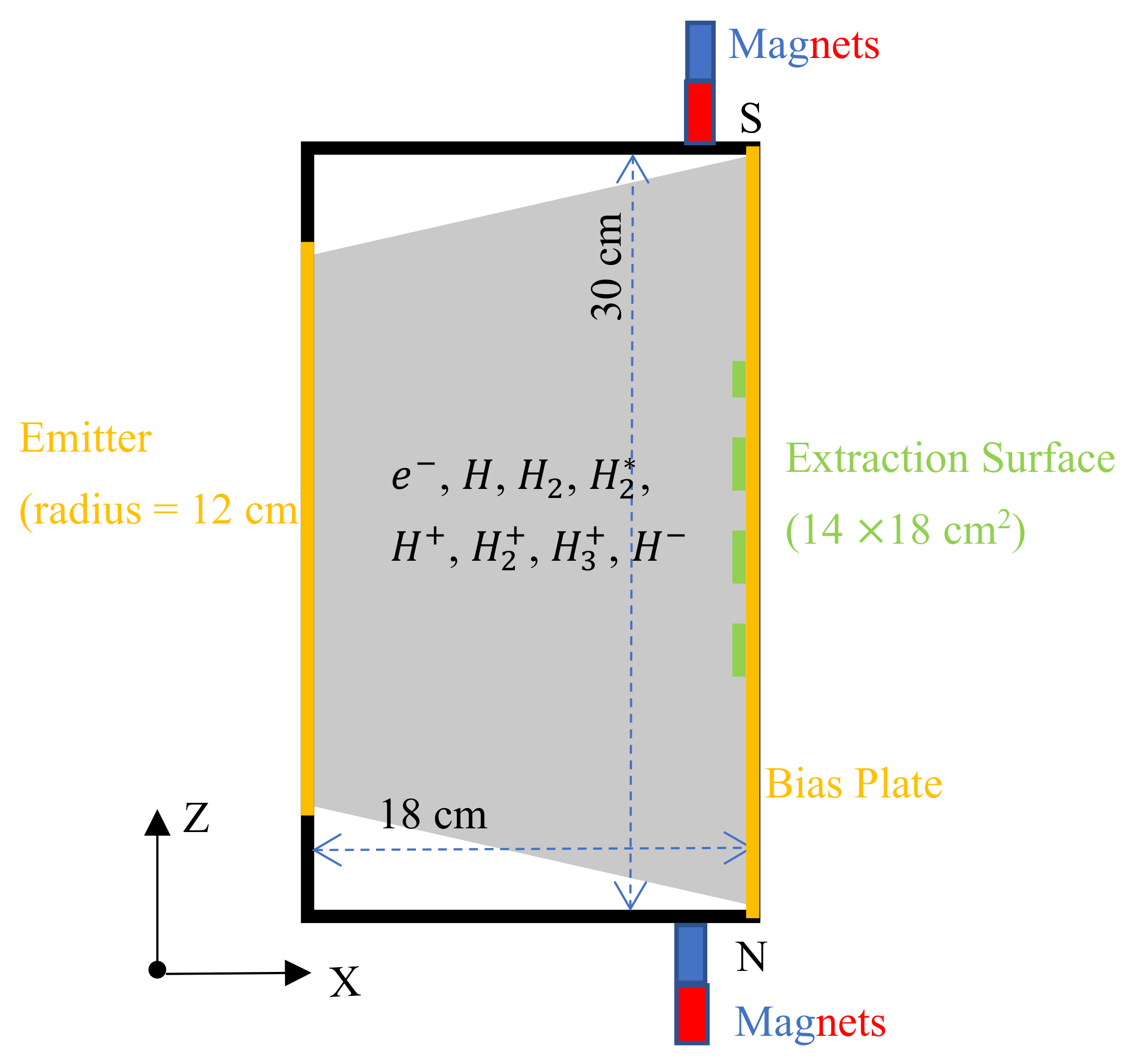
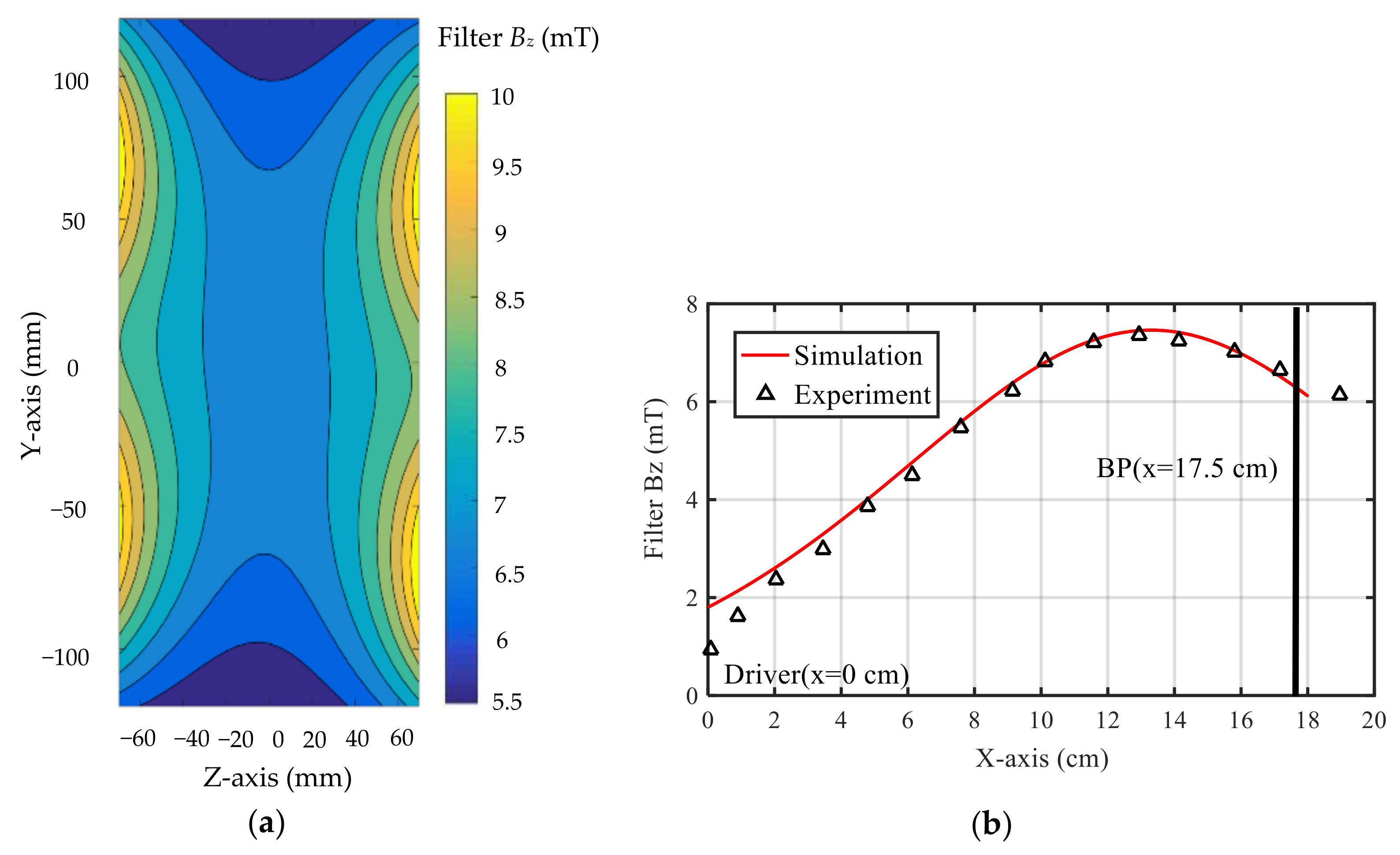
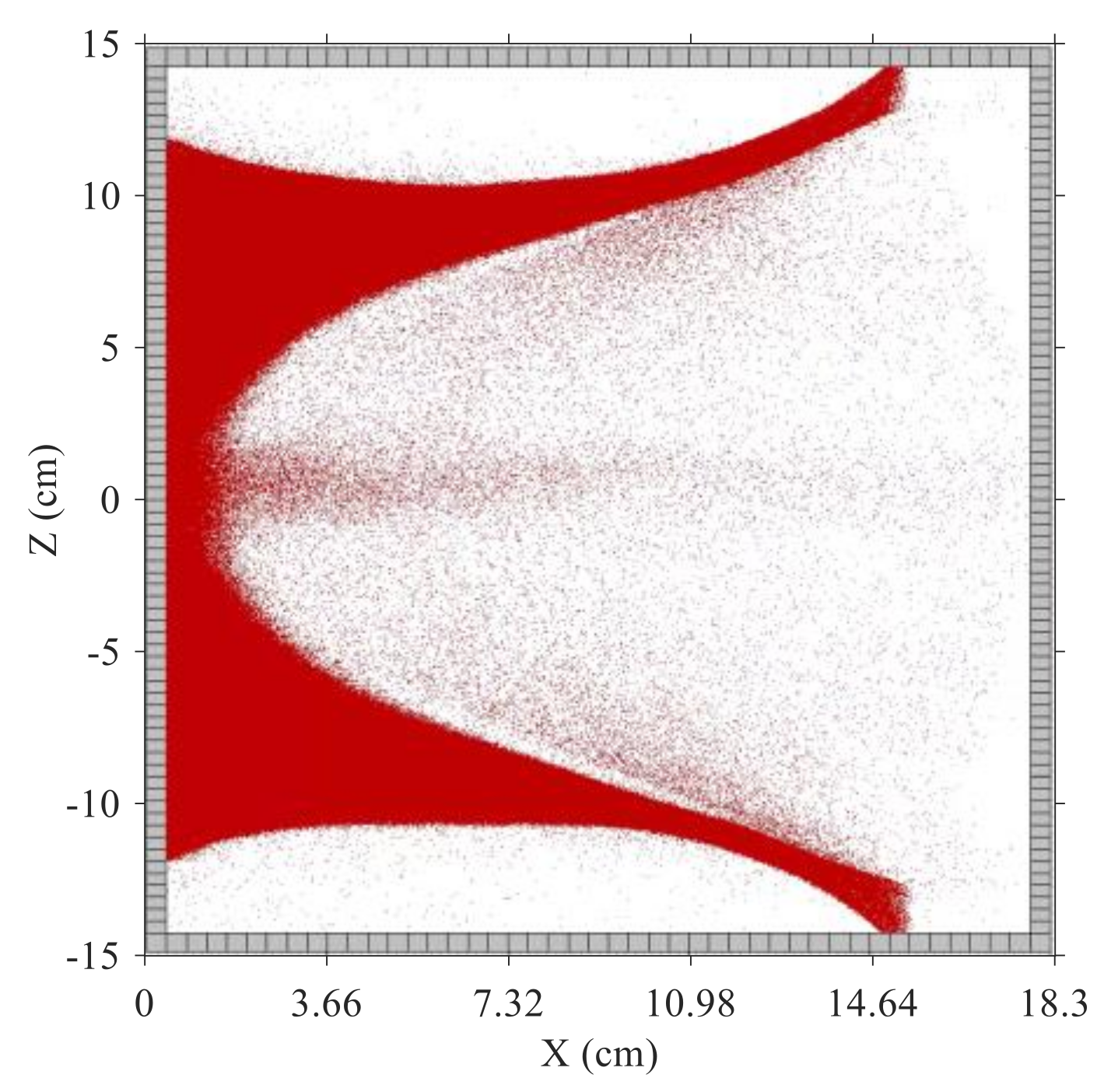
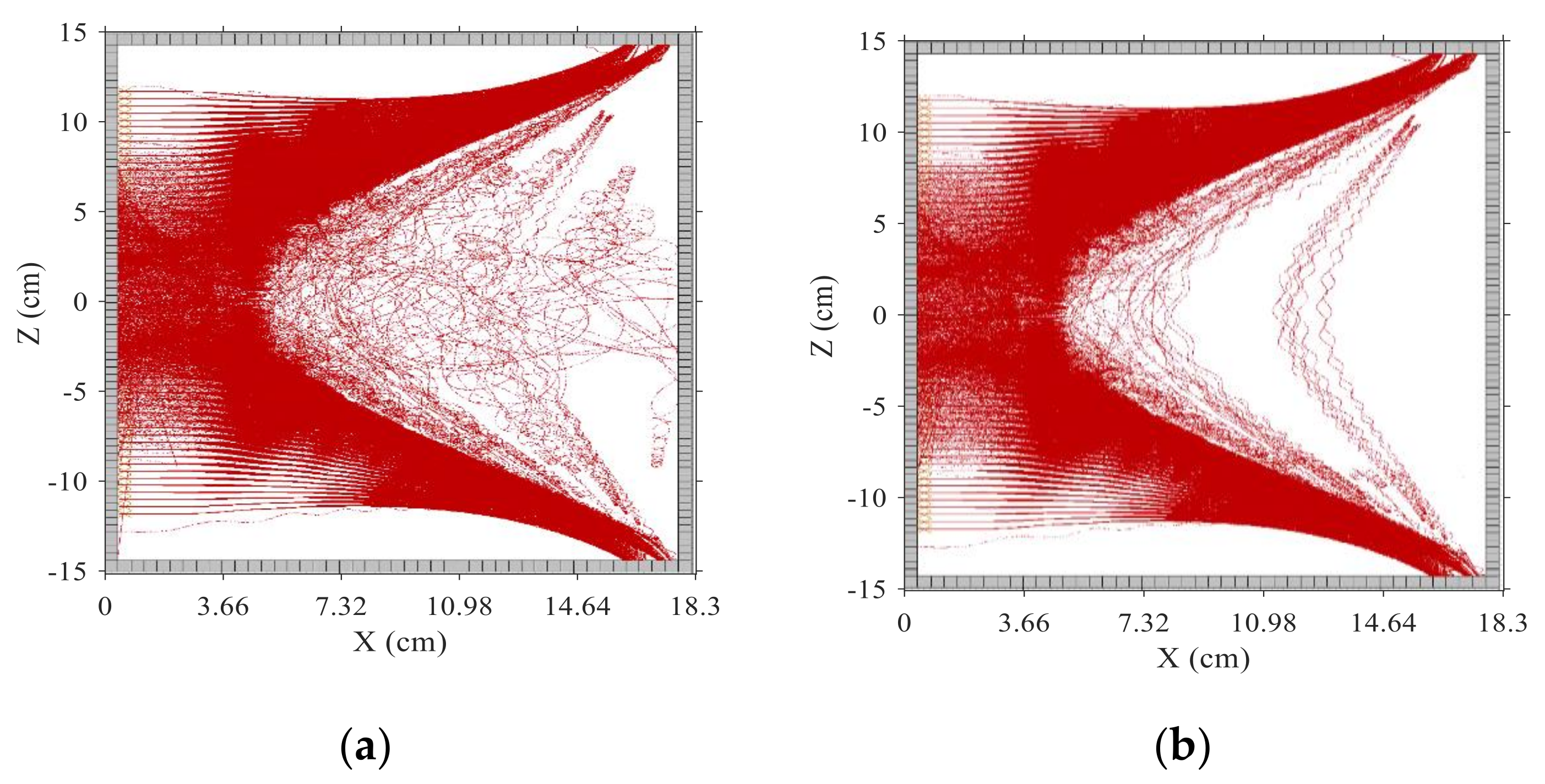
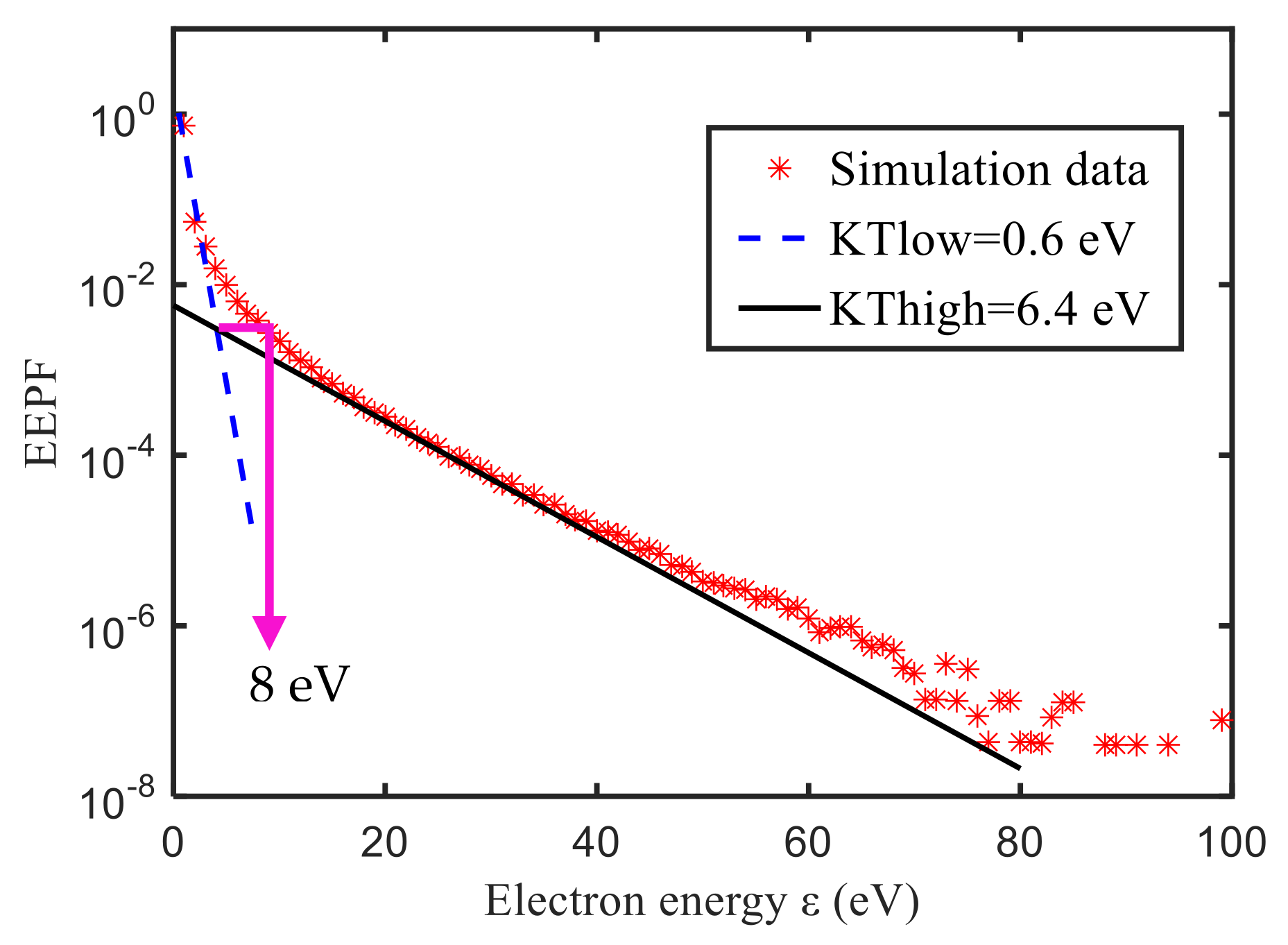


| Simulation Parameters | ||
|---|---|---|
| Hydrogen gas pressure | P | 0.6 Pa |
| Hydrogen gas temperature | 1200 K | |
| Initial electron density on the emitter surface | Ne | |
| Hydrogen gas density | NH2 | |
| Atom to molecule density ratio | NH/NH2 | 0.2 |
| Density ratio of vibrationally excited to ground state hydrogen molecules | NH2(v > 3) /NH2(v = 0) | 0.01 |
| Charged particle injection ratios | e−: H+: H2+: H3+ | 1:0.2:0.6:0.2 |
| Electron temperature | 10 eV | |
| Chamber wall potential | Φ | 0 V |
| Grid size | 4 mm | |
| Grid number | 506,250 | |
| Macro particle number of electron | ||
| CoSm magnet size | x’, y’, z’ | 9 mm × 50 mm × 13 mm |
| Extraction chamber size | X, Y, Z | 18 cm × 60 cm × 30 cm |
| Timestep | 0.1 ns | |
| Simulation time | T | s |
| Index | Collision Type | Collision Species | Threshold (eV) |
|---|---|---|---|
| 1 | Elastic | 0.01 | |
| 2 | Ionization | 13.6 | |
| 3 | Ionization | 15.42 | |
| 4 | Dissociative Ionization | 21.1 | |
| 5 | Dissociative Recombination | 0.1 | |
| 6 | Dissociative Recombination | 0.01 | |
| 7 | Dissociative Attachment | 0.1 | |
| 8 | Dissociation | 14.9 | |
| 9 | Vibrational Excitation | 0.895 | |
| 10 | Vibrational Excitation | 1.38 | |
| 11 | Electronic Excitation | 12 | |
| 12 | Electronic Excitation | 12 | |
| 13 | Electronic Excitation | 11.72 | |
| 14 | Electronic Excitation | 7.93 | |
| 15 | Electronic Excitation | 11.72 | |
| 16 | Electronic Excitation | 15 | |
| 17 | Electronic Excitation | 17.5 | |
| 18 | Dissociative Excitation | 2.7 | |
| 19 | Dissociation | 14 |
| Type | Electron Mean Energy (eV) | Extracted Electron Temperature | Extracted Electron Number |
|---|---|---|---|
| A | 6.9 | 4.4 | |
| B | 3.6 | 2.2 | |
| C | 5.3 | 3.2 | |
| D | 10.0 | 6.5 |
Publisher’s Note: MDPI stays neutral with regard to jurisdictional claims in published maps and institutional affiliations. |
© 2022 by the authors. Licensee MDPI, Basel, Switzerland. This article is an open access article distributed under the terms and conditions of the Creative Commons Attribution (CC BY) license (https://creativecommons.org/licenses/by/4.0/).
Share and Cite
Xie, M.; Liu, D.; Wang, H.; Liu, L. Study on the Correlation between Magnetic Field Structure and Cold Electron Transport in Negative Hydrogen Ion Sources. Appl. Sci. 2022, 12, 4104. https://doi.org/10.3390/app12094104
Xie M, Liu D, Wang H, Liu L. Study on the Correlation between Magnetic Field Structure and Cold Electron Transport in Negative Hydrogen Ion Sources. Applied Sciences. 2022; 12(9):4104. https://doi.org/10.3390/app12094104
Chicago/Turabian StyleXie, Mengjun, Dagang Liu, Huihui Wang, and Laqun Liu. 2022. "Study on the Correlation between Magnetic Field Structure and Cold Electron Transport in Negative Hydrogen Ion Sources" Applied Sciences 12, no. 9: 4104. https://doi.org/10.3390/app12094104
APA StyleXie, M., Liu, D., Wang, H., & Liu, L. (2022). Study on the Correlation between Magnetic Field Structure and Cold Electron Transport in Negative Hydrogen Ion Sources. Applied Sciences, 12(9), 4104. https://doi.org/10.3390/app12094104






